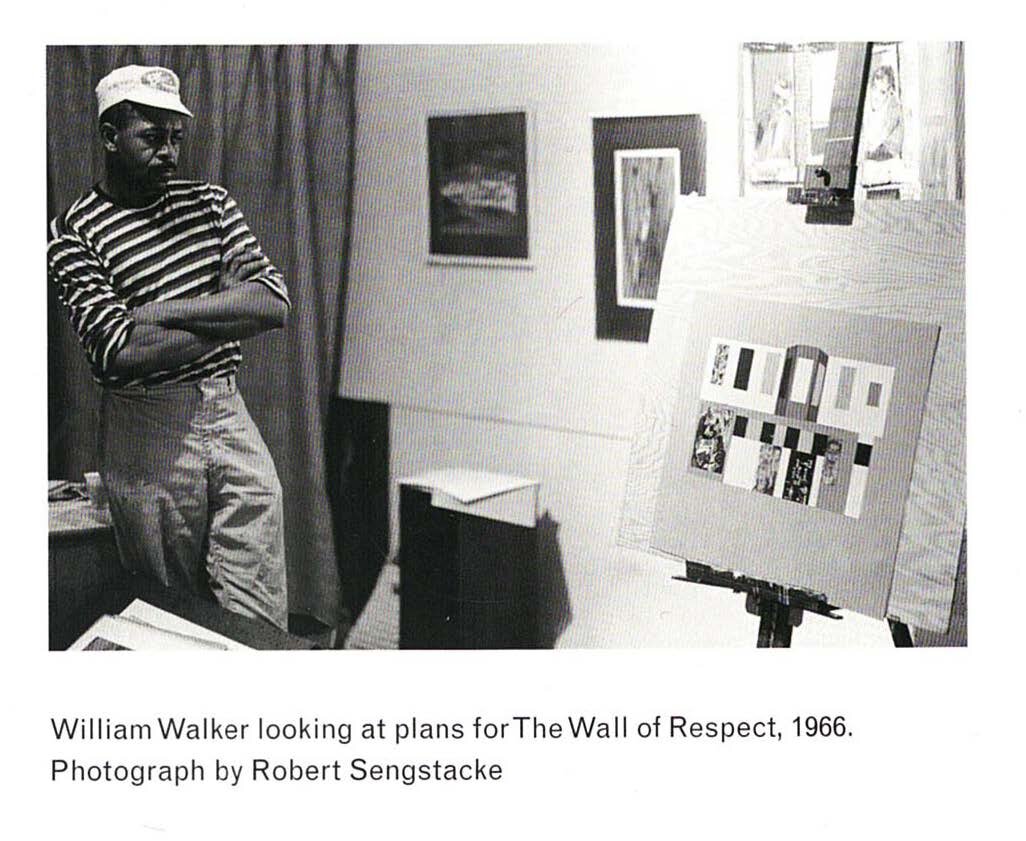
William “Bill” Walker (1927-2011)
Tennessee Page Hall
c. 1955
oil on board
21-1/2 x 23-1/2 inches
signed and dated
Free Now
1971
acrylic on canvas
44 x 38 inches
signed and dated
The El
1955
tempera on board
20-1/4 x 34 inches
signed
In August of 1967, on the southeast corner of 43rd and Langley Streets, Chicago, Illinois, a group of African American artists came together to paint the landmark mural that sparked a people’s art movement. William “Bill” Walker was instrumental in the creation of the Wall of Respect. The purpose of the project was to “honor our Black heroes and to beautify our community.” It soon became, in the words of fellow artist Jeff Donaldson,
An instantaneous shrine to Black creativity, a rallying point for revolutionary rhetoric and calls to action, and a national symbol of the heroic Black struggle for liberation in America.
Cities across American followed suit with murals of their own. Bill Walker continued to paint murals in the city of Chicago, as he had painted them before 1967, solidifying his role as father of the community mural movement - capturing the “human side of street life in the city.”
Bill Walker was born in 1927 in Birmingham, Alabama. An only child, he was initially raised by his grandmother in a desperately poor ghetto of “bleak little shacks” with outhouses known as Alley B. In 1938, he was sent north to Chicago to join his mother who worked as a seamstress and hairdresser. They lived in a variety of places in the Washington Park area and he eventually attended Englewood High School.
He was drafted in WWII and re-enlisted to receive college tuition under the GI Bill. He was a mail clerk, then an MP with the 99th Pursuit Squadron, the all black command under which the Tuskegee Airmen fought. In 1947, he painted his first murals while in the military. While stationed in Columbus, Ohio he became friends with Samella Lewis. He often stayed with her family and assisted her on a few commissions.
In 1949 he enrolled in the Columbus Gallery School of Arts. He began studying commercial art and later switched to a concentration in fine art. Walker won the school’s 47th Annual Group Exhibition “Best of Show” award in 1952. He was the first African-American to do so. Walker credits Joseph Canzani with encouraging his interest in mural painting. At school he studied the early Renaissance fresco painters. It wasn’t until after his graduation that he learned about the Mexican muralists - Diego Rivera, David Siqueiros, and Jose Clemente Orozco. He was particularly impressed with the way they incorporated structural elements in to their compositions. Walker also cited Jacob Lawrence, Charles White, and William McBride as important influences.
After graduation, Walker headed to Nashville and Memphis where he painted murals for a Baptist church, a local Elks club, and the Flamingo Club, a nightclub near Beale Street. While researching and preparing to complete another mural of a plantation scene, he had an important epiphany. He realized he needed to create art that spoke for those who had been marginalized. Walker returned to Chicago and worked as a decorative painter for a variety of north-side interior designer firms.
By the mid 1960s, Walker was formulating an idea for a mural in the area near 43rd and Langley which never came to fruition. However in May of 1967, the Organization of Black American Culture was formed and the opportunity again arose. OBAC was cofounded by artist Jeff Donaldson, sociologist Gerald McWorter, and Hoyt Fuller, editor of Negro Digest, and was dedicated to visual art, music, writing, dance, and theater. Walker floated the idea of a mural at the location. The group couldn’t just simply paint a mural and leave it at that. Walker knew the neighborhood well and secured permission from business owners, community leaders, and street gangs. The residents were a big part of the process as well. Jeff Donaldson and Eliot Hunter, Wadsworth Jarrell, Barbara Hogu-Jones, Caroline Lawrence, Norman Parish, Edward Christmas, Myrna Weaver and many others contributed sections to the wall. Walker was responsible for the section on religious leaders. Walker had originally painted the portraits of Black Muslim leader Elijah Muhammad, Nat Turner, and Wyatt Walker, a New York minister and civil rights activist, but when threatened with a lawsuit by Muhammad, who did not want to be pictured on the same wall as Malcolm X, he erased the section and replaced it with a composition of Nat Turner.
Photos from Black Artists on Art Vol. 2, Samella Lewis and Ruth Waddy, pp. 120-121.
The members of the OBAC eventually drifted apart- some, Donaldson, Jarrell, Jones, and Lawrence formed AfriCobra- and Walker, who remained in the neighborhood, came to be the “guardian of the wall.” As a result of the impact the Wall of Respect had in Chicago, similar walls were created in cities across the country. Walker worked on the Wall of Dignity in Detroit and the Wall of Truth, which was located across the street from the Wall of Respect. He co-founded the Chicago Mural Group (now known as the Chicago Public Art Group) with John Pitman Weber and Eugene Eda and completed more than 30 murals over the next four decades in working-class Chicago neighborhoods. In 1975, he formed his own mural group known as International Walls, Inc.
Walker turned increasingly to studio art in the late 70’s. Chicago State University held the exhibition, Images of Conscience: The Art of Bill Walker in 1984. The exhibit consisted of 44 paintings and drawings in three series: For Blacks Only; Red, White, and Blue, I Love You; and Reaganomics. The show was not without controversy as the images presented were not pretty, but dark representations of urban black neighborhoods. The exhibition traveled to the Vaughn Cultural Center, St. Louis and the Paul Robeson Cultural Center, Pennsylvania State University.
Most recently, Walker’s work was presented in the exhibition Bill Walker: Urban Griot, held at the Hyde Park Art Center, 2017-18.






